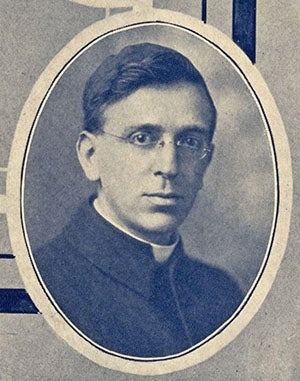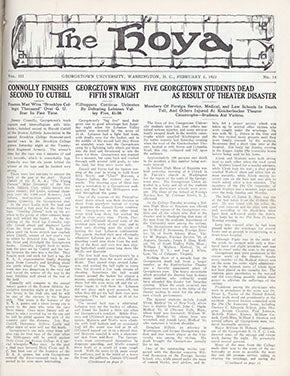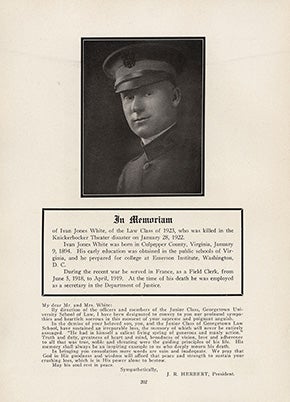The Knickerbocker blizzard brought 28" of snow to D.C. between January 27 and 28, 1922. Ranked as the largest snowstorm in Washington history, it is named for the Knickerbocker Theatre, which was located in Adams Morgan. This was the largest movie theater in D.C. at the time and seated 1700 people. By the evening of January 28, the storm was winding down and people were beginning to venture out on foot, although many streets were still impassible to vehicles. The Knickerbocker opened for an evening showing of the movie Get-Rich-Quick Wallingford. During the intermission, the theater's flat roof collapsed under the weight of accumulated snow. Ninety-eight people were killed, including five Georgetown students.
 The student body came to believe that Father Francis A. Tondorf, S.J., known on campus as "Tondy" (seen here as pictured in the 1916 yearbook), had somehow sensed the disaster before it occurred. Father Tondorf was director of the University’s Seismological Observatory as well as Professor of Biology in the College and Professor of Physiology in the Medical and Dental Schools. Tondorf Road, which runs between Prospect Street and the medical campus, is named for him. Clarence J. Schweikhardt, D’1923, recalled in a 1966 compilation of alumni reminiscences that Tondy taught us that the true purpose of learning is not to pass a test but to stimulate the mind. [He] showed us the importance of remaining open, receptive to all sources of information. Most of all he tried to impress us with the tremendous power of the mind . . . He spoke to us of . . . extrasensory perception. He believed we can influence the world outside us and, in turn, can be influenced by outside forces . . . One day apropos of nothing, he told us to stay away from the movies and keep out of crowds. We shrugged it off, thinking that the priest in him suddenly had decided movies were bad. Day after day he reminded us urgently, "Don't go to the movies. Stay out of crowds". We wondered why he hammered away so insistently on his theme, but when the roof of the Knickerbocker Theater [sic] collapsed, crushing hundreds within, we rejoiced we had not been at the movies . . . Tondy never claimed any foreknowledge of the accident, but he never again told us to stay away from the movies either. From that day, we took his advice more seriously . . .
The student body came to believe that Father Francis A. Tondorf, S.J., known on campus as "Tondy" (seen here as pictured in the 1916 yearbook), had somehow sensed the disaster before it occurred. Father Tondorf was director of the University’s Seismological Observatory as well as Professor of Biology in the College and Professor of Physiology in the Medical and Dental Schools. Tondorf Road, which runs between Prospect Street and the medical campus, is named for him. Clarence J. Schweikhardt, D’1923, recalled in a 1966 compilation of alumni reminiscences that Tondy taught us that the true purpose of learning is not to pass a test but to stimulate the mind. [He] showed us the importance of remaining open, receptive to all sources of information. Most of all he tried to impress us with the tremendous power of the mind . . . He spoke to us of . . . extrasensory perception. He believed we can influence the world outside us and, in turn, can be influenced by outside forces . . . One day apropos of nothing, he told us to stay away from the movies and keep out of crowds. We shrugged it off, thinking that the priest in him suddenly had decided movies were bad. Day after day he reminded us urgently, "Don't go to the movies. Stay out of crowds". We wondered why he hammered away so insistently on his theme, but when the roof of the Knickerbocker Theater [sic] collapsed, crushing hundreds within, we rejoiced we had not been at the movies . . . Tondy never claimed any foreknowledge of the accident, but he never again told us to stay away from the movies either. From that day, we took his advice more seriously . . .
--Lynn Conway, University Archivist
February 22, 2018
February 2, 1922 issue of The Hoya with a front page story of the Knickerbocker disaster. Click to see the entire issue online.
Tribute to Knickerbocker disaster victim Ivan White in the 1922 yearbook. Click to enlarge.


